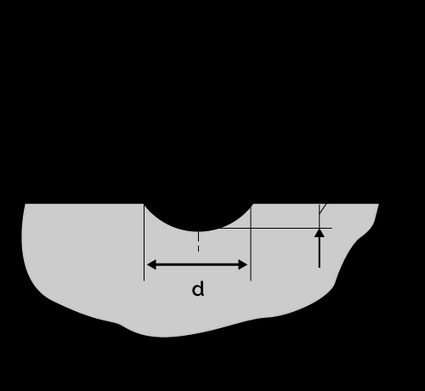Brinell Hardness Number Calculator
Our Brinell hardness number calculator will help you determine the indentation hardness of a material in the Brinell scale from the data you gathered through a Brinell hardness test. Join us in the companion article below as we take a closer look at the Brinell hardness scale and how to calculate it.
Are you interested in more material properties? Our Young's modulus calculator is worth checking out!
Brinell hardness number
The Brinell hardness number (BHN or HBW) describes the hardness of a material. The higher the number, the harder the material. The Brinell hardness test involves pressing a small metal ball into the surface of the test material with a known amount of force. The resulting indentation is then measured and converted into a hardness number.
Material | Brinell Hardness |
|---|---|
Copper | 35 HB |
Aluminum (pure) | 15 HB |
AW-6060 aluminum | 75 HB |
Glass | 1550 HB |
Rhenium diboride | 4600 HB |
The Brinell hardness number can describe the indentation hardness of various materials, from metals to plastics. It is an essential tool for engineers and manufacturers, allowing them to select the appropriate material for their applications.
The Brinell hardness scale is just one of several methods used to measure the hardness of a material. Others include the Rockwell hardness test and the Vickers hardness test.
Calculating Brinell hardness| Brinell hardness formula
In the Brinell hardness test, we use a small ball (the indentor) made of tungsten carbide or steel to penetrate the material's surface, leaving a hemispherical indent. From the load/pressure on the indentor and the diameter of the hole it makes on the material surface, we can calculate its Brinell hardness number. Our piston force calculator or hydraulic pressure calculator can assist in calculating applied load, if necessary.

The formula for the Brinell hardness number is:
Where:
- - Brinell hardness number in kgf/mm2;
- - Applied load in Newtons (N);
- - Diameter of the indentor in mm; and
- - Diameter of the indent/hole in mm.
As noted, it is common to express the Brinell hardness number in kgf/mm2. You can convert it into megapascals by multiplying it with the gravitational acceleration (~9.81m/s2).
Visit our force converter if you wish to convert the applied force from kfg to N.
How to use this Brinell hardness number calculator
This Brinell hardness number calculator is very simple to use:
- Enter the applied load .
- Provide the diameter of the indentor .
- From the Brinell hardness test, enter the diameter of the indentation on the material surface. The calculator will determine the Brinell hardness number from the given data.
Don't know the diameter of the indentor or the diameter of the hole? It's okay - provide the surface area of the indentation , and our Brinell hardness calculator will do the rest!